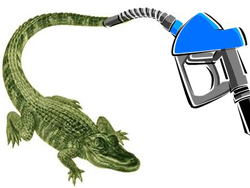Fuel produced from various animal fats is similar to biodiesel manufactured using ethanol from corn. But if the price of animal fat rose sharply, no one would really notice, since no one really eats animal fat.
And it isn't just limited to chicken, pork or beef fat , they can use alligator too. Why would they do that? Science! The report at the latest meeting of the American Chemical Society follows up on an earlier study on the potential use of gator fat as a source of biodiesel fuel. It's cool research, but there is obviously a limited amount of alligator fat lying around.
Using fat from such common sources as chicken, pork and beef could be much more practical for commercial implementation, according to Thomas Junk, Ph.D. from the University of Louisiana at Lafayette, whose earlier alligator fat study used a batch reactor and says the gator improvement came because they switched to a flow reactor to process the fat. "We set up a flow reactor, and the reaction converting alligator fat to biodiesel happened within a few minutes. That's important for commercial manufacturing, where you want to produce as much fuel as quickly as possible."

Don't laugh, it's...okay, you can totally laugh. Link: Zimmcomm
With batch reactors, reactions occur one-at-a-time in discrete batches. But in a flow reactor, the reactions run in a continuous stream.
"So this approach is not really about a brand-new fuel, but the manufacture of a known type of fuel (biodiesel) using a more efficient, less wasteful process that largely eliminates solid-waste byproducts," he explained. This method does not require a catalyst, which creates a residue, he explained. Instead, they use "supercritical methanol," which is heated to pressures and temperatures high enough to take on properties in between those of a liquid and a gas.
Another advantage of the supercritical method is that the fat doesn't have to be extracted for the process to work, Junk said. It can be used in its raw form. Crude fat and methanol would be homogenized into a slurry (semiliquid mixture) and pumped into the system. This should be a straight-forward, simple process for a manufacturer, he added.
In the earlier study, Junk and the team noted that most of the 700 million gallons of biodiesel produced in the United States (2008 data) came from soybean oil. But there has been growing concern that using soybeans and other food crops for this purpose could raise food prices.
In searching for alternative biodiesel materials, they discovered that waste alligator fat, millions of pounds of which are thrown out every year, could also work. Their experiments showed that oil extracted from alligator fat can easily be converted into biodiesel. And now they plan to test other waste animal fats, such as those from chickens and cows. They predict that these fats also can be easily converted to biodiesel with the flow reactor system.




Comments